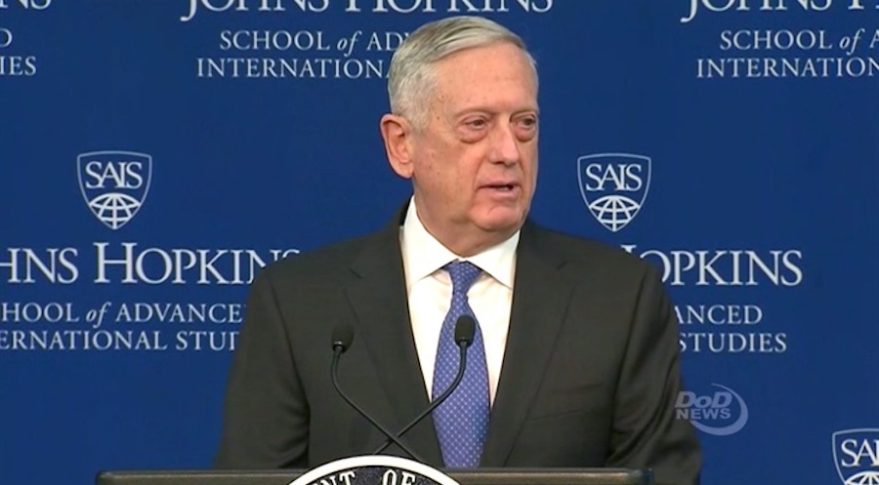Pentagon Space Posture: Don't Even Try to Mess with Us

WASHINGTON — The title of the 2018 National Defense Strategy — "Sharpening the American Military's Competitive Edge" — pretty much sums up the tone that has been set by Secretary Jim Mattis.
The plan is straightforward: compete, deter and win. And that applies to outer space, too. "Space is like any other domain of war," Mattis said Friday following a speech at the Johns Hopkins School of Advanced International Studies here, where he laid out the broad themes of the new strategy.
Asked by a member of the audience to elaborate on how the U.S. military would fight enemies in space, Mattis delivered one of his trademark one-liners: "Don't try it."
In space, the United States has to become so strong to make it obvious to adversaries that they would have "no benefit to be gained" from attacking U.S. systems, Mattis said. "What that means is that we have to have capabilities to deny them what they want to achieve."
Capabilities in this case are not traditional military weapons but space systems that are resilient to attack. "It's not about what you might think, guns in space shooting at each other," Mattis said. To deter enemies, the military has to make it hard, if not impossible, for them to interfere with U.S. satellites. "For every satellite up, we'll have a hundred more that could launch as fast as they're taken out," he said.
Mattis' explanation for how to make space more resilient echoes the thinking of other military leaders who have called for the Pentagon to stop using large, expensive spacecraft and instead put up constellations of cheaper small satellites that can be replaced quickly if a conflict erupted and U.S. systems came under attack.
Preferably, said Mattis, conflicts in space should be resolved diplomatically. "We'll come up with arms control agreements at some point, and we'll start getting this under control." Aggressors would be punished with economic and other types of international sanctions, he added. "In space we will do our best to deter. But for right now, it's about sizing up the problem and making certain that our diplomats will be negotiating from a position of strength."
Breaking space news, the latest updates on rocket launches, skywatching events and more!
The 2018 strategy mostly is classified and the Pentagon only released a short unclassified summary. It is the first such document since the 2014 Quadrennial Defense Review.
One of the central themes is that the United States faces formidable military competitors like China and Russia. "Our competitive edge in every domain of warfare — air, land, sea, space, and cyberspace — is eroding," Mattis said in the speech. "We will modernize key capabilities, recognizing we cannot expect success fighting tomorrow's conflicts with yesterday's weapons or equipment."
"Military uses of space are emerging," he said. "During a conflict, attacks against our critical defense, government, and economic infrastructure must be anticipated."
The strategy calls for investments in space and cyberspace, nuclear deterrent forces, missile defense, advanced autonomous systems, and resilient and agile logistics.
But Mattis' ambitious plans are all contingent on Congress providing the financial resources, which the secretary acknowledged is no guarantee in the current political environment. He chastised lawmakers for acting like "spectators" in the budget fight and not doing right by the serving men and women of the U.S. military.
"We need Congress back in the driver's seat of budget decisions, not in the spectator's seat of the budget control act's indiscriminate and automatic cuts," Mattis said.
Defense budget analyst Todd Harrison, of the Center for Strategic and International Studies, noted that it is "somewhat fitting" that Mattis released the National Defense Strategy on the very day that Congress is scrambling to try to pass yet another continuing resolution to avoid a government shutdown.
The reality is that a strategy that is written without regard for resource constraints is just a "bunch of words on a page," he said. "In fairness, if you look back at previous QDRs and other strategy reviews, that often is the case — that it's a lot of talk." The ground truth will be in the budget. "You really have to wait for the budget to see what the strategy means in practice, what are they actually going to do or not do."
This story was provided by SpaceNews, dedicated to covering all aspects of the space industry.

Sandra Erwin covers the military and national security beat as a Senior Staff Writer at SpaceNews. Sandra, based in Arlington, Virginia, specializes in Defense Department and Intelligence Community space programs, policy, budgets, technology and the industry that supports this sector. She joined SpaceNews in October 2017. Before coming to SpaceNews, Erwin covered the U.S. military, the Pentagon, Congress and the defense industry for over two decades as editor of the National Defense Industrial Association's National Defense Magazine and Pentagon correspondent for Real Clear Defense.

